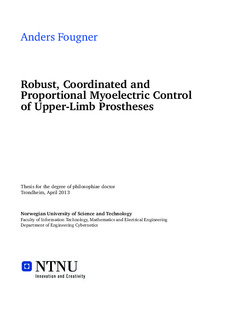| dc.contributor.advisor | Stavdahl, Øyvind | nb_NO |
| dc.contributor.advisor | Kyberd, Peter J | nb_NO |
| dc.contributor.author | Fougner, Anders | nb_NO |
| dc.date.accessioned | 2014-12-19T14:06:31Z | |
| dc.date.available | 2014-12-19T14:06:31Z | |
| dc.date.created | 2013-04-02 | nb_NO |
| dc.date.issued | 2013 | nb_NO |
| dc.identifier | 613927 | nb_NO |
| dc.identifier.isbn | 978-82-471-4293-6 | nb_NO |
| dc.identifier.isbn | 978-82-471-4294-3 | nb_NO |
| dc.identifier.uri | http://hdl.handle.net/11250/260782 | |
| dc.description.abstract | From a prosthesis user's viewpoint there is a wide range of challenges in prosthesis research, despite the recent progression in development and manufacturing of multifunction prostheses. A small part of these challenges has been solved during the work underlying this thesis.
The scope of this thesis is to review and assess the existing methods used for proportional control, develop and demonstrate methods for artifact cancellation to increase the control reliability, design and implement a viable strategy for coordinated proportional control of multiple joints, suggest an unambiguous terminology for prosthesis control systems, and contribute to the clinical assessment of the results.
The thesis is organized as a compendium of scientific papers.
Paper A contains a pilot study of how to attenuate force induced artifacts in surface electromyography by measuring the external forces.
Paper B contains a pilot study of the adverse effects of limb position on pattern recognition based myoelectric control, hereafter called the limb position effect. Papers C, D and E contain the continuation of this project. The limb position effect was resolved by using multiple limb positions in training of the control system, and further improvements were achieved by additional use of accelerometers as a measurement of the limb position (relative to gravity). It was demonstrated that these two solutions are efficient in normally limbed subjects. Inspired by this research, further studies on prosthesis users have been reported by others.
Paper F contains a comprehensive review of proportional myoelectric control of upper limb prostheses. The main findings was that the composition of the training data set and the choice of training method and optimization criterion are topics that need to be addressed in future research. This paper also contains a review of terminology in prosthesis control systems, and an unambiguous terminology has been suggested; a work that may improve communication, increase the understanding of the subject and stimulate to more structured research.
Paper G contains development and practical testing of simultaneous proportional control of two motor functions (wrist rotation and hand open/close). This required development of prosthesis guided training for proportional control, and design of a novel prosthesis socket (equivalent) for normally-limbed subjects.
This thesis has contributed towards the long-term goal of offering an intuitive and robust control system to the end users of upper limb prostheses. | nb_NO |
| dc.language | eng | nb_NO |
| dc.publisher | NTNU | nb_NO |
| dc.relation.ispartofseries | Doktoravhandlinger ved NTNU, 1503-8181; 2013:98 | nb_NO |
| dc.subject | electromyography | en_GB |
| dc.subject | EMG | en_GB |
| dc.subject | myoelectric | en_GB |
| dc.subject | myoelectric signal | en_GB |
| dc.subject | surface EMG | en_GB |
| dc.subject | sEMG | en_GB |
| dc.subject | proportional | en_GB |
| dc.subject | prosthesis | en_GB |
| dc.subject | upper limb | en_GB |
| dc.subject | hand prosthesis | en_GB |
| dc.subject | prosthesis control | en_GB |
| dc.subject | myoelectric control | en_GB |
| dc.subject | proportional control | en_GB |
| dc.subject | simultaneous proportional control | en_GB |
| dc.subject | robust control | en_GB |
| dc.subject | sensor fusion | en_GB |
| dc.subject | multimodal approach | en_GB |
| dc.subject | artifact cancellation | en_GB |
| dc.subject | artifact suppression | en_GB |
| dc.subject | prosthesis use | en_GB |
| dc.subject | prosthesis user | en_GB |
| dc.subject | amputee | en_GB |
| dc.subject | outcome measure | en_GB |
| dc.subject | pattern recognition | en_GB |
| dc.subject | rehabilitation | en_GB |
| dc.subject | biomedical engineering | en_GB |
| dc.title | Robust, Coordinated and Proportional Myoelectric Control of Upper-Limb Prostheses | nb_NO |
| dc.type | Doctoral thesis | nb_NO |
| dc.source.pagenumber | 156 | nb_NO |
| dc.contributor.department | Norges teknisk-naturvitenskapelige universitet, Fakultet for informasjonsteknologi, matematikk og elektroteknikk, Institutt for teknisk kybernetikk | nb_NO |
| dc.description.degree | PhD i elektronikk og telekommunikasjon | nb_NO |
| dc.description.degree | PhD in Electronics and Telecommunication | en_GB |

